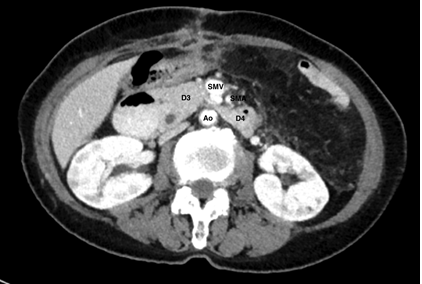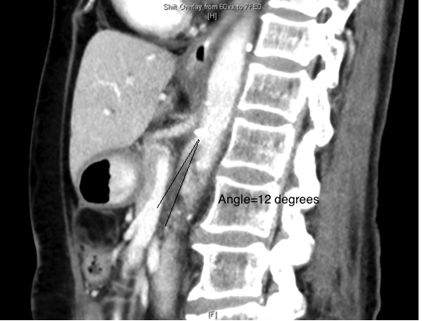Superior Mesenteric Artery Syndrome After Laparoscopic Low Anterior Resection
Sinan Albayati1*, Matthew J Morgan2
1Department of Surgery, Bankstown-Lidcombe Hospital, Sydney, NSW, Australia
2South Western Sydney Clinical School, University of New South Wales, Sydney, NSW, Australia
*Corresponding Author: Dr. Sinan Albayati, PO Box 381, Moorebank NSW 1875, Australia
Received: 01 August 2019; Accepted: 14 August 2019; Published: 20 August 2019
Article Information
Citation: Sinan Albayati, Matthew J Morgan. Superior Mesenteric Artery Syndrome After Laparoscopic Low Anterior Resection. Journal of Surgery and Research 2 (2019): 116-119.
View / Download Pdf Share at FacebookAbstract
Superior mesenteric artery syndrome (SMAS) is an uncommon cause of duodenal obstruction due to the extrinsic compression of the third part of the duodenum by the superior mesenteric artery (SMA) as it passes anterior to it. We present a case of a 70-year old lady with abdominal pain, postprandial vomiting and decreased oral intake following laparoscopic low anterior resection with endoscopic and radiological findings suggesting SMAS. The cause was the traction on the transverse mesocolon and the middle colic artery to place the transverse colon in the deep pelvis. This, in turn, has lead to traction and flattening of the SMA against the aorta causing SMAS. The patient was successfully managed conservatively with enteral feeding and surgery was avoided.
Keywords
Superior mesenteric artery syndrome (SMAS), Nasojejunal, Aortomesenteric angle
Superior mesenteric artery syndrome (SMAS) articles, Nasojejunal articles, Aortomesenteric angle articles
Superior mesenteric artery syndrome articles Superior mesenteric artery syndrome Research articles Superior mesenteric artery syndrome review articles Superior mesenteric artery syndrome PubMed articles Superior mesenteric artery syndrome PubMed Central articles Superior mesenteric artery syndrome 2023 articles Superior mesenteric artery syndrome 2024 articles Superior mesenteric artery syndrome Scopus articles Superior mesenteric artery syndrome impact factor journals Superior mesenteric artery syndrome Scopus journals Superior mesenteric artery syndrome PubMed journals Superior mesenteric artery syndrome medical journals Superior mesenteric artery syndrome free journals Superior mesenteric artery syndrome best journals Superior mesenteric artery syndrome top journals Superior mesenteric artery syndrome free medical journals Superior mesenteric artery syndrome famous journals Superior mesenteric artery syndrome Google Scholar indexed journals Nasojejunal articles Nasojejunal Research articles Nasojejunal review articles Nasojejunal PubMed articles Nasojejunal PubMed Central articles Nasojejunal 2023 articles Nasojejunal 2024 articles Nasojejunal Scopus articles Nasojejunal impact factor journals Nasojejunal Scopus journals Nasojejunal PubMed journals Nasojejunal medical journals Nasojejunal free journals Nasojejunal best journals Nasojejunal top journals Nasojejunal free medical journals Nasojejunal famous journals Nasojejunal Google Scholar indexed journals Aortomesenteric angle articles Aortomesenteric angle Research articles Aortomesenteric angle review articles Aortomesenteric angle PubMed articles Aortomesenteric angle PubMed Central articles Aortomesenteric angle 2023 articles Aortomesenteric angle 2024 articles Aortomesenteric angle Scopus articles Aortomesenteric angle impact factor journals Aortomesenteric angle Scopus journals Aortomesenteric angle PubMed journals Aortomesenteric angle medical journals Aortomesenteric angle free journals Aortomesenteric angle best journals Aortomesenteric angle top journals Aortomesenteric angle free medical journals Aortomesenteric angle famous journals Aortomesenteric angle Google Scholar indexed journals nasojajunal feeding articles nasojajunal feeding Research articles nasojajunal feeding review articles nasojajunal feeding PubMed articles nasojajunal feeding PubMed Central articles nasojajunal feeding 2023 articles nasojajunal feeding 2024 articles nasojajunal feeding Scopus articles nasojajunal feeding impact factor journals nasojajunal feeding Scopus journals nasojajunal feeding PubMed journals nasojajunal feeding medical journals nasojajunal feeding free journals nasojajunal feeding best journals nasojajunal feeding top journals nasojajunal feeding free medical journals nasojajunal feeding famous journals nasojajunal feeding Google Scholar indexed journals Nasojejunal tube articles Nasojejunal tube Research articles Nasojejunal tube review articles Nasojejunal tube PubMed articles Nasojejunal tube PubMed Central articles Nasojejunal tube 2023 articles Nasojejunal tube 2024 articles Nasojejunal tube Scopus articles Nasojejunal tube impact factor journals Nasojejunal tube Scopus journals Nasojejunal tube PubMed journals Nasojejunal tube medical journals Nasojejunal tube free journals Nasojejunal tube best journals Nasojejunal tube top journals Nasojejunal tube free medical journals Nasojejunal tube famous journals Nasojejunal tube Google Scholar indexed journals duodenal obstruction articles duodenal obstruction Research articles duodenal obstruction review articles duodenal obstruction PubMed articles duodenal obstruction PubMed Central articles duodenal obstruction 2023 articles duodenal obstruction 2024 articles duodenal obstruction Scopus articles duodenal obstruction impact factor journals duodenal obstruction Scopus journals duodenal obstruction PubMed journals duodenal obstruction medical journals duodenal obstruction free journals duodenal obstruction best journals duodenal obstruction top journals duodenal obstruction free medical journals duodenal obstruction famous journals duodenal obstruction Google Scholar indexed journals transverse colon articles transverse colon Research articles transverse colon review articles transverse colon PubMed articles transverse colon PubMed Central articles transverse colon 2023 articles transverse colon 2024 articles transverse colon Scopus articles transverse colon impact factor journals transverse colon Scopus journals transverse colon PubMed journals transverse colon medical journals transverse colon free journals transverse colon best journals transverse colon top journals transverse colon free medical journals transverse colon famous journals transverse colon Google Scholar indexed journals enteral feeding articles enteral feeding Research articles enteral feeding review articles enteral feeding PubMed articles enteral feeding PubMed Central articles enteral feeding 2023 articles enteral feeding 2024 articles enteral feeding Scopus articles enteral feeding impact factor journals enteral feeding Scopus journals enteral feeding PubMed journals enteral feeding medical journals enteral feeding free journals enteral feeding best journals enteral feeding top journals enteral feeding free medical journals enteral feeding famous journals enteral feeding Google Scholar indexed journals
Article Details
1. Introduction
Superior mesenteric artery syndrome (SMAS) is an uncommon cause of duodenal obstruction due to the extrinsic compression of the third part of the duodenum by the superior mesenteric artery (SMA) as it passes anterior to it. It is postulated that a pad of mesenteric fat around the origin of the SMA protects the duodenum against compression. Although having a low BMI is a predisposing factor, other additional factors are necessary to develop SMAS. One precipitating factor is rapid weight loss that leads to loss in retroperitoneal fat. This reduces the mesenteric fat pad around the SMA leading to narrowing of the angle between the aorta and SMA causing SMAS [1]. Other precipitating factors include increased lordosis and external compression and SMAS has been reported following trauma, spinal corrective surgery and body casting [1, 2]. SMAS has been reported following ileal pouch anal anastomosis [3]. However, to our best knowledge, there are no reports of SMAS following low anterior resection. We describe a case of SMAS that developed in a patient who had laparoscopic low anterior resection for a left colon cancer.
2. Case Report
A 70-year old Asian woman was initially seen with a metachronous left colon adenocarcinoma following a previous anterior resection for a sigmoid cancer thirteen years earlier. A laparoscopic low anterior resection was performed where the rectum was resected distal to the previous anastomosis with a transverse colon anastomosis to the rectum. On postoperative day 13, she presented to the emergency department with abdominal pain, postprandial vomiting and decreased oral intake. Her weight was 50 kg and her body mass index (BMI) was 18.7 kg/m2. On examination, she was dehydrated. Abdomen was mildly distended with epigastric tenderness. She was hyponatraemic (Na 118 mmol/L), hypokalaemic (K 2.9 mmol/L) and hypochloraemic (Cl 77 mmol/L). Urea and creatinine were normal (6.2 mmol/L, and 56 μmol/L). A CT scan showed the third part of the duodenum was extrinsically compressed between the aorta and the superior mesenteric vessels, causing a dilatation of the second part of the duodenum. Aortomesenteric angle was 12°, and the distance was 4mm. Upper gastrointestinal endoscopy showed a large amount of bile in the stomach, dilated duodenum and a tight extrinsic constriction of the third part of the duodenum. There was no access to the jejunum. Balloon-assisted enteroscopy was done to pass the scope into the jejunum and insert a nasojejunal feeding tube. The position of the feeding tube in the jejunum was confirmed with a supine abdominal x-ray and feeding was commenced via the nasojejunal tube. She slowly improved following nasojajunal feeding and was discharge home. Nasojejunal tube was removed week 4 following resolution of the duodenal obstruction and patient tolerating diet.
Ao-Aorta; SMA-superior mesenteric artery; SMV-superior mesenteric vein; D3-duodenum third part; D4-duodenum 4th part

Figure 1: Aortomesenteric compression of D3/D4 in a patient with SMAS.

Figure 2: Aortomesenteric angle in a patient with SMAS.
3. Discussion
SMAS has been reported following ileal pouch anal anastomosis [3-5]. It is thought that the SMA, being the main vascular pedicle for the constructed ileal pouch, is stretched and flattened against the aorta when the pouch is placed in the deep pelvis and this reduces the aortomesenteric angle and distance. In our case, SMAS occurred following redo low anterior resection that was caused by traction on the transverse mesocolon and middle colic artery trying to place the transverse colon in the deep pelvis. This, in turn, has lead to traction and flattening of the SMA against the aorta causing SMAS.
The usual presentation of SMAS includes epigastric pain, anorexia, nausea, vomiting, early satiety and postprandial fullness [6]. CT is the most commonly used modality to diagnose SMAS. It can show an extrinsic obstruction of the duodenum by the SMA and can be used to measure the aortomesenteric angle and distance in these patients. The reported median normal aortomesenteric angle is 45° (38-56°) and the normal aortomesenteric distance is 10-20 mm. The reported median aortomesenteric angle and distance in patients with SMAS are 10.5° (7.2-19.7°) and 5mm (3-8 cm) respectively [6]. In this case, the aortomesenteric angle was reduced to 12° and the aortomesenteric distance was reduced to 4mm.
Several surgical procedures have been described for SMAS patients, including gastrojejunostomy, duodenojejunostomy, and the division of the ligament of Treitz [6]. However, conservative management should be the first choice aiming at feeding the patient to gain weight, restore retroperitoneal fat and increase the aortomesenteric angle. This can be achieved by enteral feed through a nasojejunal feeding tube or total parenteral nutrition. The reported success rate of medical management is 71% with a recurrence rate of 15% [6].
In summary, we present a case that illustrates SMAS can occur following low anterior resection that has resulted from traction on the transverse colon to reach the deep pelvis causing stretching and flattening of mesocolon, middle colic vessels, and the SMA reducing the aortomesenteric angle. This was successfully managed conservatively with enteral feeding and surgery was avoided.
References
- Ahmed AR, Taylor I. Superior mesenteric artery syndrome. Postgrad Med J 73 (1997): 776-778.
- Welsch T, Buchler MW, Kienle P. Recalling superior mesenteric artery syndrome. Dig Surg 24 (2007): 149-156.
- Kitade H, Matsuura T, Yanagida H, et al. Superior mesenteric artery syndrome after ileal pouch-anal anastomosis for colon cancer associated with ulcerative colitis: report of a case. Surg Case Rep 1 (2015): 27.
- Truong AR, Rodriguez-Bigas MA, Nguyen ST, et al. Superior mesenteric artery syndrome after ileal pouch anal anastomosis. Am Surg 79 (2013): 14-16.
- Goes RN, Coy CS, Amaral CA, et al. Superior mesenteric artery syndrome as a complication of ileal pouch-anal anastomosis. Report of a case. Diseases of the Colon and Rectum 38 (1995): 543-544.
- Lee TH, Lee JS, Jo Y, et al. Superior mesenteric artery syndrome: where do we stand today? J Gastrointest Surg 16 (2012): 2203-2211.


 Impact Factor: * 4.2
Impact Factor: * 4.2 Acceptance Rate: 72.62%
Acceptance Rate: 72.62%  Time to first decision: 10.4 days
Time to first decision: 10.4 days  Time from article received to acceptance: 2-3 weeks
Time from article received to acceptance: 2-3 weeks 